Mara's Triumph
Written by Rick Archer
Last Update: December 2012
Our 2011 cruise
to the Virgin Islands featured a marvelous series of
adventures created by Mara Rivas.
It might seem
odd to be writing about this trip a year and a half later,
but I was terribly distracted by a serious problem upon my return from the VI trip. I am pleased to say the
problem went away, but at
the time the last thing on my mind was writing cruise
stories.
I was so pre-occupied with worry, I completely forgot about this trip. By
the time my problem was resolved a month later, this trip
was in the rearview mirror.
Unfortunately, once you let the trail grow cold, it is hard
to pick up the scent again. Oh well, better
late than never. Now that I
have some free time, let's revisit these great adventures
|
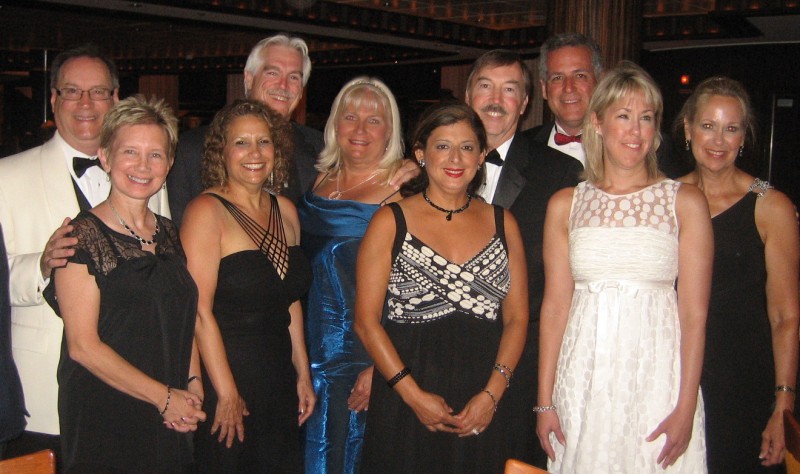
Joe, Patty, Marla, Rick, Joan, Mara, Bruce,
Kurt, Tiffany, Jean |
| |
|
A
Brief History of Puerto Rico
Puerto Rico
has been described countless times as the "Key to the
Caribbean". Although this nickname
made a lot more sense back in Age of Imperial Expansion, in
recent times Puerto Rico has magically regained its status
as a key player in the fortunes of the Caribbean Sea.
We get to that aspect shortly.
So where exactly
is Puerto Rico?
As opposed to
Cuba which is about 100 miles from Key West, Puerto Rico is
1,000 miles southeast of Miami, Florida.
If you study the
map, you will see Puerto Rico seems to be part of an ancient
land bridge that perhaps once connected what we now call
Florida to the northeast coast of South America.
Another ancient
land bridge using Cuba seems to link Puerto Rico to the
Yucatan Peninsula. In the middle of the circle rests
the Caribbean Sea and its bitter past under
Spanish domination.
|
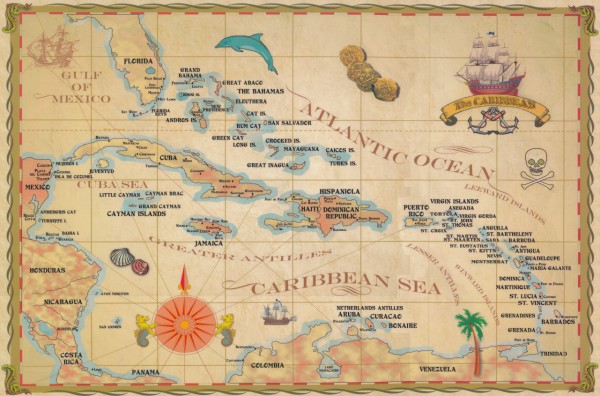 |
In Spanish, Puerto Rico
means "the Door to Riches". All the European
powers during the Age of
Imperial Expansion
knew that Puerto Rico guarded the door to the
valuable Caribbean. A tremendous
amount of wealth flowed through Puerto Rico as the last stop before
heading back to Europe.
Although Columbus first
landed in the Bahamas back in 1492, he could have just as easily
landed in Puerto Rico. As sailing ships relied on wind
propulsion back in those days, the winds and the waters directed all
ships to either the Bahamas or
Puerto Rico. Since any ship headed to
the Americas from Europe was automatically guided to the shores of
Puerto Rico, it was nearly impossible for any ship coming from
Europe to avoid detection. San Juan was the doorway to the
Caribbean.
|
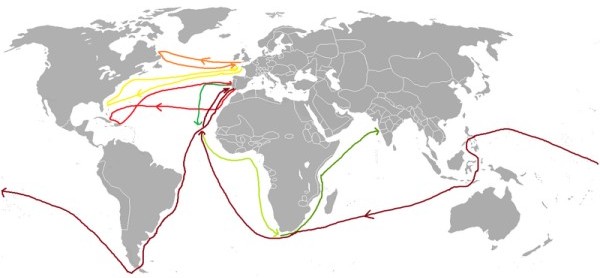 |
The Spanish understood
that whoever controlled this strategically located island was in a
strong position to monitor all ships coming and going in the New
World. Therefore Spain jealously guarded its control of Puerto
Rico for over 400 years.
Due to the island's
prominence in the Caribbean, a network of fortifications was built
to protect the transports of gold and silver from the New World to
Europe. Because of the rich cargoes, San Juan became a
frequent target of the foreign powers of the time.
Over the centuries,
Spain built a virtually impregnable fortress known as Morro
Castle. This huge stone structure overlooked the
harbor at San Juan, Puerto Rico's major city. Its powerful
guns made sure no ship could enter the harbor unharmed.
One glance at the castle
makes it hard to believe, but some ships tried to attack anyway. It
was no use. Despite several attacks by the French, Dutch, and
British, Spain never once lost
control of its valuable possession.
That changed in 1898.
As a result of its defeat in the Spanish-American War, Spain ceded
Puerto Rico to the United States.
|
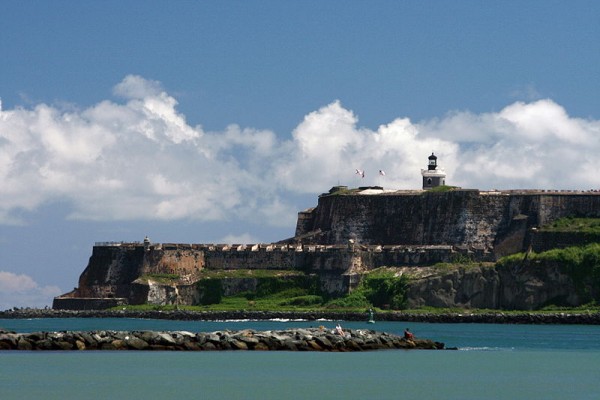 |
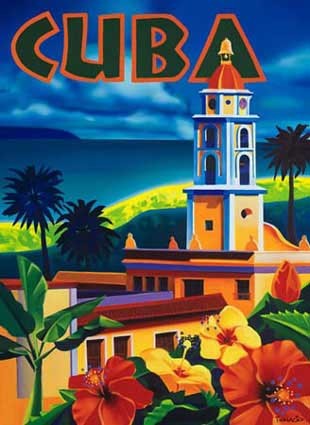 |
However, at the
time, Puerto Rico was an afterthought. The real prize
to the US was the chance to increase its influence in Cuba.
Although Cuba
gained formal independence from the US soon after the war in
1902, Cuba remained a
virtual satellite state of the USA until 1959.
The US wasted no
time getting its fingers into the island. Under Cuba's new
constitution, the US retained the right to intervene in
Cuban affairs and to supervise its finances and foreign
relations.
No issue has
been more aggravating to the Cubans than Guantanamo Bay. Under the Platt Amendment, the U.S.
leased the Guantánamo Bay naval base from Cuba under the
1903 Cuban-American Treaty. Cuba granted the United
States a perpetual lease of the area. The current
government of Cuba regards the U.S. presence in Guantánamo
Bay as illegal and insists the Cuban-American Treaty was
obtained by threat of force in violation of international
law.
The U.S.
relationship with Cuba was not always so acrimonious.
At the turn of
the Twentieth Century, America was Cuba's hero. After
all, the USA had liberated Cuba from the hated Spanish.
In addition, the US was a major consumer of Cuban crops.
It was an excellent partnership.
Cuba was not
only an agricultural paradise, its close proximity to
Florida made tourism effortless. Huge amounts of US
tourism money flowed into Cuba. Havana,
Cuba, became the Las Vegas of the Fifties. It was the
place to be. In addition, many U.S. companies invested
heavily in Cuba.
|
Unfortunately,
Cuba's leaders lined their pockets with American dollars.
Consequently the gap between the wealthy and the poor
created tremendous social unrest.
This climate of
unrest gave rise to the communist politics of Fidel Castro
and the Cuban Revolution.
In a dramatic 1959 New Year's Eve upheaval, Castro
entered Havana and overthrew the pro-USA government of
Bautista.
America had once
been the good guys. However, half a century of
exploitation had changed all that. In the days to
come, Castro embraced the Cold War friendship of the Soviet
Union. Suddenly the Cold War had come to the footsteps
of American soil.
One island's
loss is another island's gain. Now that Cuba was lost
to the USA, over the next 50 years Puerto Rico began a
steady
climb to the prominence it enjoys today.
|
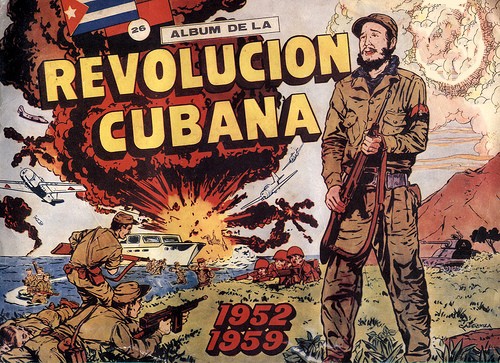 |
|
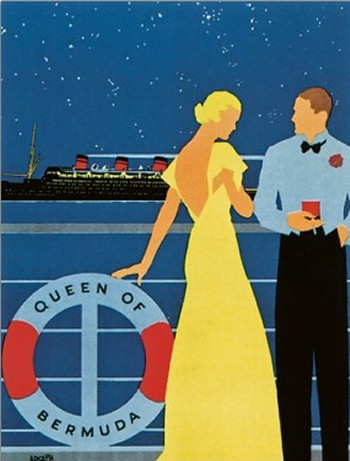 |
Puerto Rico
Makes a Comeback
During
the first half of the Twentieth Century, the cruise
industry catered primarily to the rich. Then in 1958
it all came to a crashing halt. Just like the
dinosaurs, overnight the cruise industry faced
extinction. Can you guess what happened?
I will tell you in a moment.
The
origin of the cruise liner can be traced back to the
19th century. Commercial ships were built to ferry
mail, cargo, and wealthy passengers across the sea.
A major part of their business was transporting
immigrants to the United States.
Unfortunately, the immigrants were treated about as
well as the cargo was. They were placed at the
bottom of the ship in “steerage” class. In steerage,
passengers were responsible for providing their own
food. They slept in whatever space was
available in the hold.
When the
mass migration of immigrants to the U.S. slowed in
the early part of the Twentieth Century, the
emphasis switched to building massive and ornate
floating hotels. The design of these liners
attempted to minimize the discomfort of ocean
travel, masking the fact of being at sea and the
extremes in weather as much as possible through
elegant accommodations and planned activities.
The
years between 1920 and 1940 were considered the most
glamorous years for transatlantic passenger ships.
Cruise liners were used primarily to shuttle wealthy
Americans and Europeans across the Atlantic.
These were the days when the rich and famous were
seen enjoying luxurious settings on numerous
newsreels viewed by the general public.
And then
suddenly it all nearly ended.
|
|
The first non-stop airplane flight to Europe in 1958 marked
the end of transatlantic business for ocean liners.
Practically overnight the cruise customers discarded the
luxurious ocean liners for cheaper fares and faster trips
across the sea. This was an absolute disaster for the
cruise industry. Passenger ships were sold and lines
went bankrupt from the lack of business.
Fortunately the
cruise industry found a new niche. The 1960s witnessed the
rise of the modern cruise
industry. They
made changes to attract
"middle class" passengers who would
have never had
the money or the nerve to
mix elbows with the elite on the
expensive super
liners of the 30s, 40s,
and 50s.
Now the emphasis switched from
trans-Atlantic trips to round trips. Why not take
people to a beautiful island for a couple days, then bring
them back home? To the relief of the industry, this
switch worked like a charm. Cruise ship companies
began to
concentrate on economical vacation trips in the Caribbean.
They created a relaxed ambience
aboard ship as opposed to the snooty approach.
|
The Caribbean
Sea basically saved the day.
Did you know the
Caribbean is the most popular destination in the world for
cruise ships?
With stunning tropical islands such as St. Thomas, this
makes a lot of sense.
Cruise ships concentrated on creating a
more casual environment.
They added extensive on-board entertainment.
Now that the role of ships
to transport people to a
particular destination had diminished, the
emphasis had shifted to the voyage
itself.
A day at sea
became just as valuable as a day at port. Gambling was
added and each ship became a floating Las Vegas.
The new cruise line image was
solidified with the popularity of the TV series The Love
Boat which ran 1977
to 1986.
Puerto Rico became a key player in this grand
new experiment. The cruise industry played a major role in
Puerto Rico's return to prominence.
Puerto Rico was a practical choice.
|
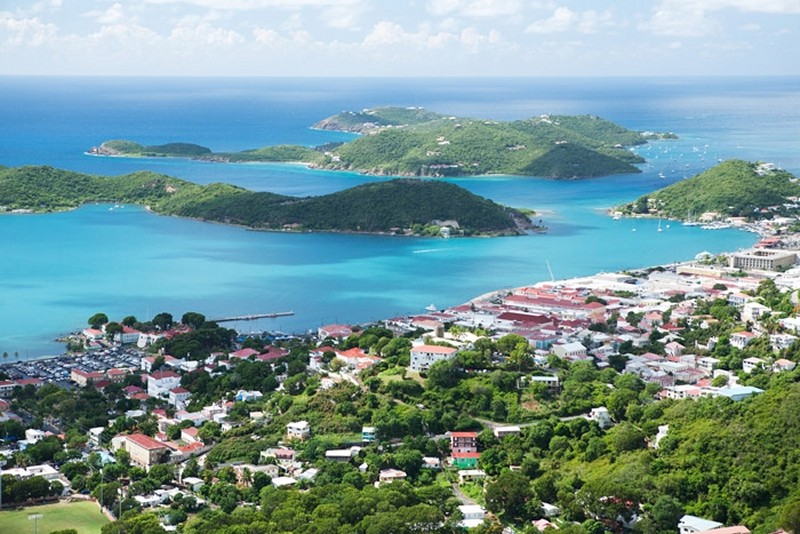 |
While Miami was only
100 miles from the former playground of Havana, Miami was 1,000 miles away from the
many islands of the Eastern Caribbean.
Why depart from
Miami when a plane flight to San
Juan would bypass a 1,000 miles?
Any tourist on the eastern seaboard would just as soon skip
Miami and hop a
plane to San Juan instead.
A look at the
map shows that Puerto Rico is conveniently situated at the
doorway to a vast array of islands to the south.
Best of all, San
Juan was situated on American soil. Any investment in
Puerto Rico was unlikely to suffer the same devastation that
occurred in Havana.
And that is how
San Juan became the second largest cruise port in the
Western Hemisphere (Miami is #1). Today San Juan welcomes over a
million cruise ship passengers every year.
It doesn't hurt
that "Old San Juan" just happens to be a pretty special
place to visit in its own right. Within walking
distance from cruise pier, the old walled city is a treat.
If you have a day between stops or a day before heading
home, this is where you want to be.
Today San Juan's
status as the gateway to the lovely Eastern Caribbean
islands brings countless tourists from around the globe to
its shores.
Puerto Rico has
now been a territory of the United States for over 100
years. Thanks to the USA, the island enjoys one of the
highest standards of living of the Caribbean Islands.
The relationship
with the US has been good for Puerto Rico. Its citizens know
it. The people constantly evaluate their future.
The three options are to remain a protectorate, become an
independent nation or to become the 51st State.
In a
non-binding referendum held on Election Day, Nov 6,
2012, 65% voted for statehood if the offer is ever made.
Based on what I have seen, this would be a win-win for both
sides.
|
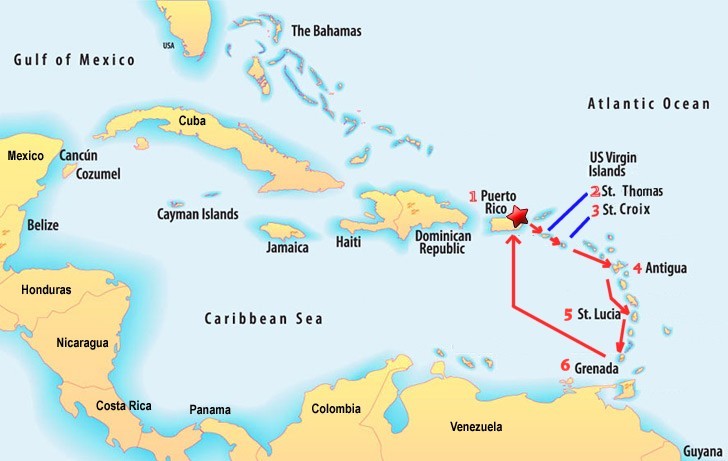
A list of
the five islands we visited on our 2011 Virgin Islands Cruise
Trip
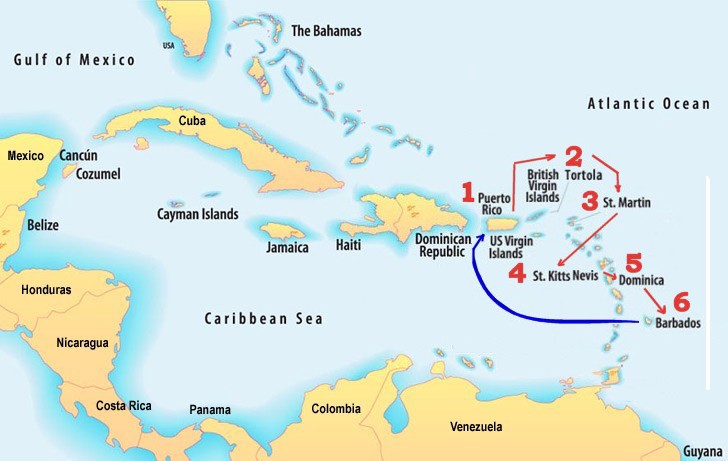
A list of
the five new islands we visited on our 2012 Dominica Cruise Trip
There are still plenty more islands to visit - Saba, St. Barts,
Anguilla, Virgin Gorda in the British Virgin Islands,
Montserrat, Martinique, Guadalupe, and Trinidad & Tobago,
|
| |
|
San
Juan, Puerto Rico
There are three physical features about
San Juan that made it the perfect citadel for the Spanish
Empire in the New World.
First, it is
conveniently located on the northeast corner of the island.
Any sentry would have no trouble spotting a ship heading
towards Puerto Rico from Europe.
Second, San Juan
is divided into two parts. "Old San Juan" is actually
situated on an island. The near point of the island to
land is separated by 150 yards of water. This
prevented an army from landing safely somewhere else in
Puerto Rico and attacking by land... although several armies
did use this trick to lay siege to the island. However
the siege tactic didn't work because guerillas from the
other part of the island would sneak up at night and
sabotage the siege armies from behind.
Third, Morro
Castle on the northwest tip of the island could easily
control the narrow half-mile bottleneck that separated San
Juan's vast harbor from the Atlantic Ocean. No ship
could possibly brave those guns and sail into the harbor
unscathed.
|
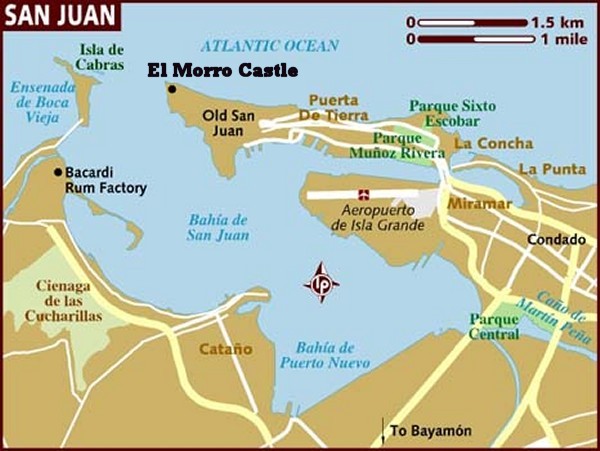 |
El Morro Castle
and Old San Juan held a formidable position indeed.
Here is a caption I read when I visited El Morro. The
caption reads:
"By the end
of the 16th century, Spain controlled the Caribbean,
Mexico, Central America, and a large portion of South
America.
The
Spaniards proceeded to extract the enormous wealth of
the New World.
Every year,
Spain sent two armed ship convoys to pick up portable
treasures and deliver them safely back to Spain.
To safeguard
territories and treasure fleet, Spain built a network of
fortifications in key harbors throughout the Caribbean.
El Morro,
one of the forts, was built to protect the city and
harbor of San Juan."
|
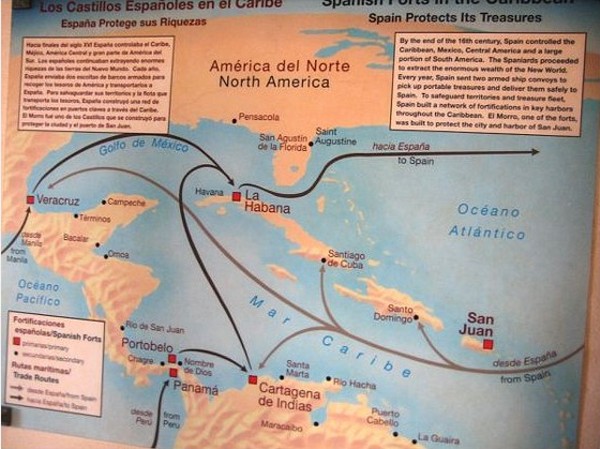 |
Considering how
impressive El Morro Castle is even today, when I finally got
a chance to visit, I was very curious to learn how the
United States managed to defeat this "undefeated" location
in 1898. The high elevation, thick stone walls, and
massive long cannons made me wonder how any ship could beat
ever it.
I was reminded
of the The Guns of Navarone. This was a
fictional movie of how a British team crossed occupied Greek
territory during WW II in order to destroy the massive
German gun emplacement that commands a key sea channel.
When I saw El
Morro castle and its guns with my own eyes, I wondered how
in the absence of air power this position could ever fall.
I found it very odd that although the 1898 U.S. attack was
described in great detail, no description existed of how the
Morro Castle fortification actually fell. I left
feeling frustrated.
It wasn't until
I began to write this story that I figured it out.
The
Castle was damaged in 1898, but it was never beaten.
After the
Spanish surrendered in Cuba, they gave Puerto Rico to the
U.S. in return for money and peace. As far as I can
tell, El Morro Castle is still undefeated to this day.
|
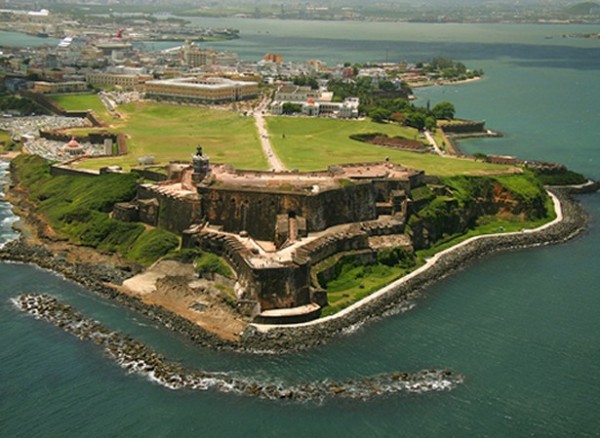 |
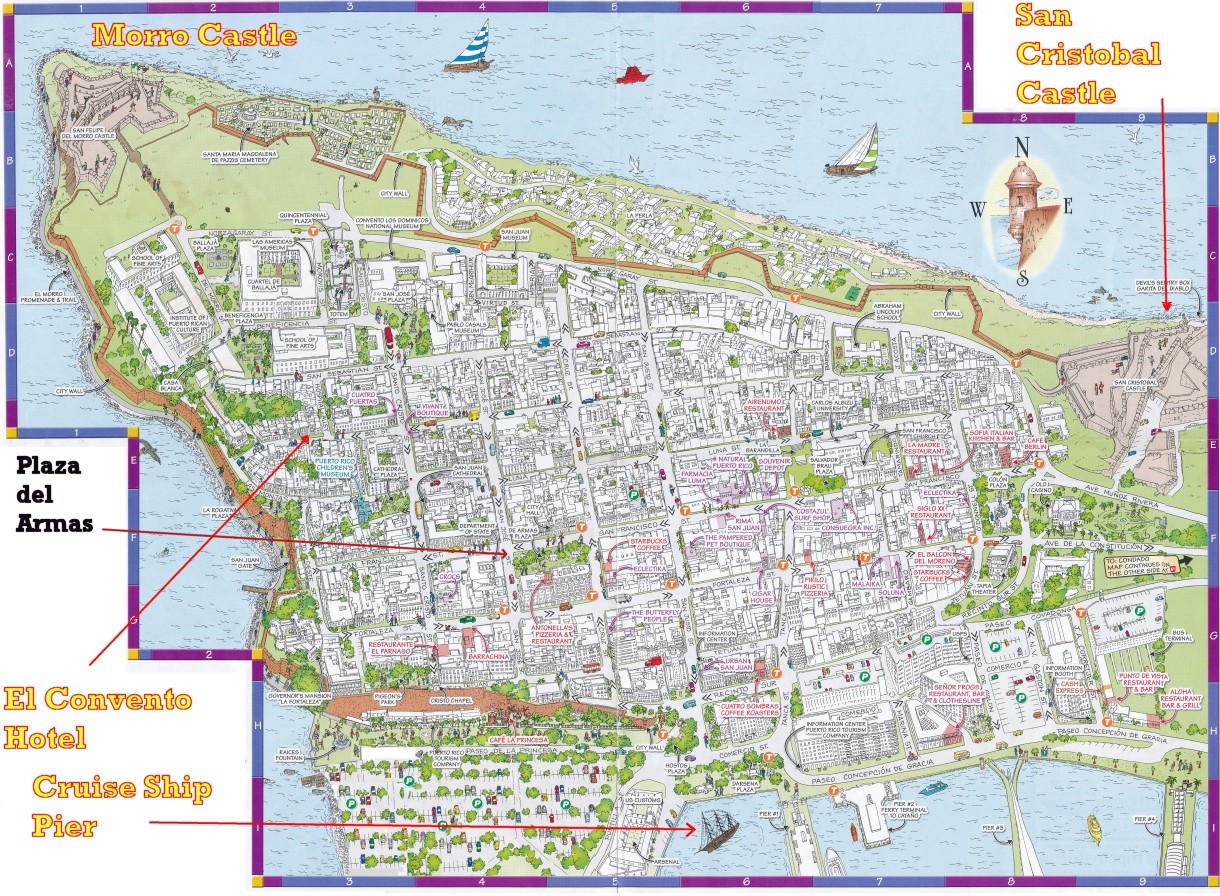
Preservation of Old San
Juan
Rick's Note: There is so much to
see in Old San Juan. With an understanding of its
historical value and its interest to tourists, the officials
have made a real effort to preserve Old San Juan as much as
possible. Here is a reprint of a very good article about the
town.
Guarding the Glories of San Juan
By Eric Wills | From
Preservation | January/February 2009
Today preservationists are saving
sites in and around San Juan,
Puerto Rico’s capital city. But it
is not easy at all.
Wander into the Plaza de Armas, a main square in Old
San Juan, and you'll find a million
pigeons and no shortage of American
food chains—Starbucks, Howard
Johnson, Burger King.
In response, independent and trendy
restaurants such as Dragonfly (Latin-Asian fusion) have
sprouted on South Fortaleza Street, dubbed Sofo.
And boutique hotels have started to
multiply. But renovating historic buildings for new uses is
not always easy in Old San Juan.
For example,
Hotelier Raul Emilio
Fournier says it took him eight years to buy a building for
one of his recent projects. Almost 40 people had partial
ownership, thanks to a convoluted chain of inheritance
dating back generations.
However,
Fournier was
determined to see his project through. He traveled
as far as to Spain and to the
Dominican Republic in search of
signatures. He even managed to track down an
Argentinian cab driver in Buenos Aires.
In the end,
he secured rights to the
building. and opened the
eight-room Casa Herencia hotel.
My name is Eric Wills. I've come
to San Juan Cathedral on a rainy September morning
with Anibal Sepulveda, a professor of planning at the
University of Puerto Rico.
The first thing I notice, after my
eyes adjust to the half-light filtering through the
stained-glass windows, is the ornate marble tomb.
Beneath the marble lies Ponce De León, the Spanish
conquistador who colonized Puerto Rico in 1508 (five years
before he discovered Florida, Sepulveda tells me with a
smile).
Sepulveda whisks me down the aisle
to a stone spiral staircase in the oldest surviving part of
the 16th-century cathedral. "This helix, it's like the DNA
of the city," he says, as we ascend the dark passageway
before emerging onto the roof.
Here I find my breathtaking introduction to Old San Juan:
The city, the historic heart of Puerto Rico's capital,
spreads out before us in a dramatic and colorful panorama.
High above the narrow streets, with the roaring Atlantic
Ocean in the distance, I see houses in all shades of muted
pastels, huddled behind massive walls built by the Spaniards
to defend their Caribbean colony.
All of this architecture, I
realize, arose nearly a century before the first English
colonists landed in Jamestown and Plymouth, and it remains
remarkably intact today. Its appearance Spanish, its soul
Puerto Rican, Old San Juan draws hordes of tourists who
arrive each week by cruise ships that dock in the city's
harbor.
I've come here to find out how this historic city survived
once-vocal calls for demolition, and to venture beyond its
formidable walls. Although the struggle to save Old San Juan
has largely been won, I quickly learn that elsewhere on this
fiercely proud island, some battles are just beginning.
Old San Juan sits on a tiny spit of land resembling a
whale's tail on Puerto Rico's northern coast, separated from
the newer part of the city (and the rest of the island) by a
small channel.
Old San Juan
is a city made for walking.
It stretches about 2 1/2 miles at its longest point. The
entire perimeter is just slightly longer than six miles. I
can get practically anywhere I want in 30 minutes or less.
And its a good thing that walking is so much fun because the
traffic is horrible. The streets in many places are so
narrow than even a bicycle can barely fit throught. I
honestly believe I can get to most places faster by walking.
Today
I spend a good part of my stay wandering the narrow streets.
I see the blue sheen of the street
cobblestones constantly changing, depending on the angle and
intensity of the light. The beauty here largely derives from
the city's intimate scale. Wherever I go
two-story houses and some
three-story houses predominate
The
rhythm occasionally interrupted by larger showpieces such as
the cathedral or nearby El Convento, a convent-turned-hotel
built in 1646. El Convento is a Historic Hotel of America, a
program of the National Trust for Historic Preservation.
Conveniently, the San Juan Cathedral is right across the
street.
I love to visit the massive walls
that line the coastline cradle the city and heighten its
intimacy. At strategic points along the walls the Spanish
built two forts, El Morro and San Cristóbal,
to stand guard against invading navies launching attacks
from the Atlantic. The forts remain today.
They stand as magnificent, weathered testaments to
the city's once great importance
in Spain's Caribbean empire.
English forces tried three times to capture San Juan
without success. The Dutch set fire to the city in
1625 but couldn't take El Morro either.
Not until the Spanish-American War
in 1898 did the United States, with Puerto Rican support,
finally wrest control of San
Juan—and the island—from the Spanish.
In 1947, after decades of U.S. military rule, Puerto Rico
began electing its own governor.
It was then that the Americans
helped launch Operation Bootstrap, an ambitious plan to
transform the island—long dependent on sugar and tobacco
production—into an industrial powerhouse.
Unfortunately,
at this time the
historic old city faced imminent
destruction.
Ricardo
Alegría is the man credited with
saving old San Juan during the mid
Sixties.
"San Juan was a slum area," recalls
Alegría, the first director of the Institute of Puerto Rican
Culture.
"Cristo Street was a haven for
prostitution. Property
values were down. I was told that San Juan should be a
little New York. That was the cry. Let's
destroy everything and rebuild."
Today Alegria lives in a faded
pink house on San José Street. He is 87 years old, with a
white mustache and an easy smile.
We sit one evening in his open
courtyard. I listen intently as
Alegria explains how he dismissed calls for
demolition and helped the government establish tax credits
for individuals who restored buildings.
To set an example, he purchased and
restored this house, instead of building a new one as he had
originally planned.
Alegría recounts one of his many battles, fought in the late
1960s over the landmark building that now houses the General
Archives of Puerto Rico.
José Bosch, head of the Bacardi rum
family, purchased the building (designed initially in the
1890s as a hospital) and wanted to tear it down to build a
high-rise.
But then
Alegría declared his opposition to the plan.
This prompted Bosch to
storm into his office, livid. So Alegría floated an
alternative proposal: What if the institute bought the
building? Bosch asked how much.
"I was not prepared," recalls Alegría. "The first thing that
came to mind was $500,000."
Bosch threw a chair and yelled, "You are worse than
that damned Fidel!!"
Bosch was as
perturbed by the low price as by the government's
constant intrusion into his
private affairs.
"I'm not doing this for me," Alegría told him. "I'm doing
this for my country." In the end, Bosch agreed to sell the
building for $500,000. This was a
good start.
Before I go, Alegría gives me a tour of his house, the walls
decorated with paintings by the acclaimed Puerto Rican
artist José Campeche, as well as a tile collection dating to
the 16th century.
Alegría says he has started
donating his papers, books, and artifacts to museums and
libraries, to ensure their preservation, and I ask how he
wants to be remembered. He doesn't hesitate: "As the man who
defended Puerto Rican heritage."
In the midst of the kind of
standoff Alegria had with rum baron Bosch,
one lesson looms large. On a small island such as Puerto
Rico, it's especially important for new construction to
blend with historic buildings in a thoughtful way.
"Everybody says that planning has been a disaster for
decades," says José Luís Vega, the executive director of the
Institute of Puerto Rican Culture. "Everybody agrees on that
much."
The funny thing is, the Spanish did a pretty good job of
planning in the first place. I'm sitting one evening with
Javier Bonnin Orozco in his apartment in Ponce, about 75
miles from San Juan on the island's southern coast. Over
rum-and-cokes, Bonnin, an architect, tells me that the
Spanish built towns with main squares surrounded by
churches, banks, markets. "The centers connect everybody.
They're the identity of the towns," he says.
In the mid-20th century, Puerto Ricans embraced the American
obsession with the automobile, abandoning squares and city
centers in favor of sprawling suburbs and gated communities.
But in recent years, the Puerto Rican government has tried
to inspire the revitalization of city centers, using a
variety of tax credits and other incentives.
It took time, but eventually an entire
new generation of Puerto Ricans began to embrace the past.
These structures were their roots, their history.
Their ancestors died here. Why not preserve the Old
Town and let it become a living memory?
Today no
building can be taken down without permission. All
buildings are expected to be painted and renovated to a
certain standard. A person is not allowed to let his
house deteriorate without penalty. To own a building
in Old Town San Juan requires a sense of civic pride.
As the cruise
industry lures countless visitors to the city, everyone has
seen the value of tourism to the community. There can
be no doubt that the restoration effort has paid off in ways
both financial and intangible.
The visitors
themselves have helped. There is a real sense of pride
that comes from the compliments of the visitors as they walk
the streets and smile at what they see.
Now a sort of
snobbery has set in. Keep your home beautiful or get
out. If an owner can't respect the attitude, better to
simply sell and relocate to a house in the suburbs.
Everyone who stays is expected to pitch in.
Wherever I look,
I see the architecture reflects the city's bohemian
personality. I love the
porches and verandas that front
the streets. They convey a
spirit of openness and relaxation.
However my favorite pastime is to find an open door or an
open gate which lets me peer in and see the beautiful
courtyard gardens hidden within.
At the end of my trip, I'm drawn back to Old San Juan. I
wake up early on my final morning for a walk around El Morro
Castle.
The cruise ships haven't docked yet
this morning, so I find myself alone, but for the runners
circling a large grassy field in front of the fort. The sky
is a clear blue; the Atlantic Ocean gleams in the distance.
I can easily conjure images of
Ponce de León first landing on Puerto Rico, or of workers
building the aqueduct that permitted San Juan's expansion
and led to a protracted period of sprawl and modernization.
So many layers of Puerto Rico's history survive, the
medieval and the modern residing in such proximity, that it
is no surprise that shaping the island's architectural
future inspires controversy.
As I head for my car and drive
toward the cranes that rise over San Juan, I realize that
this is a city embarked on a sometimes tumultuous journey
into the future. One thing seems certain, though:
This is one place determined to
never let go of its past.
|
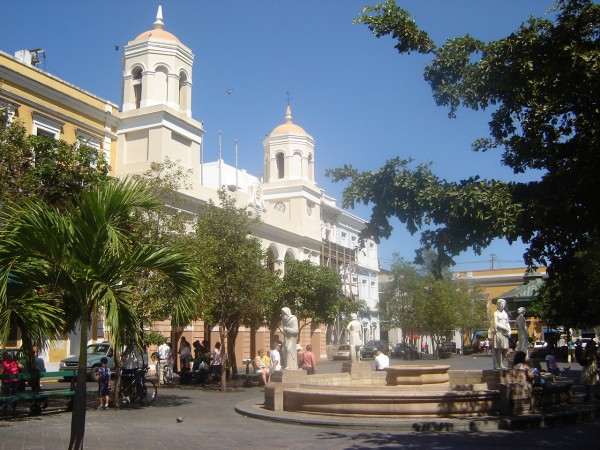
Plaza de
Armas
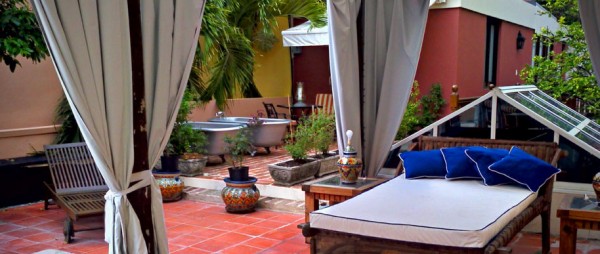
Casa
Herencia
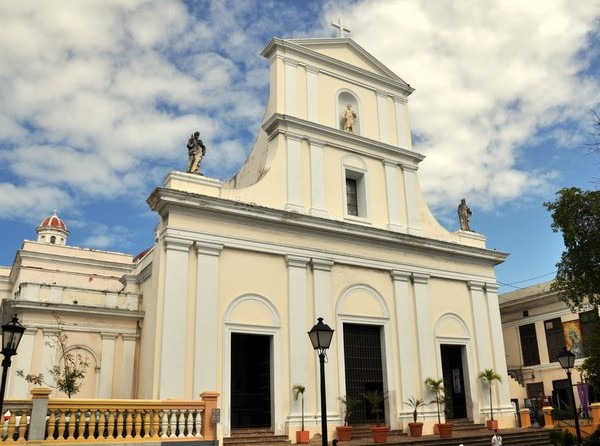
San Juan
Cathedral
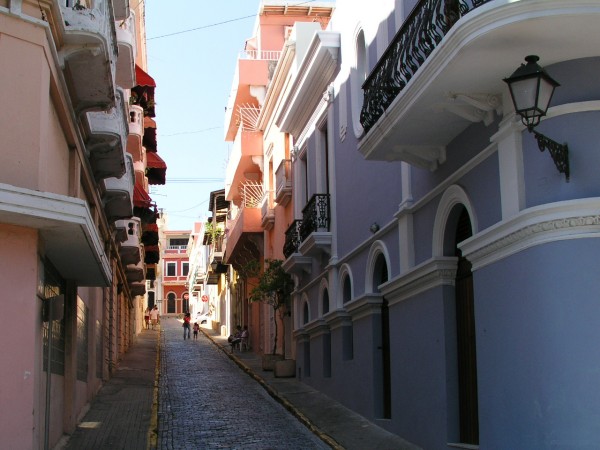
The narrow
streets of Old San Juan
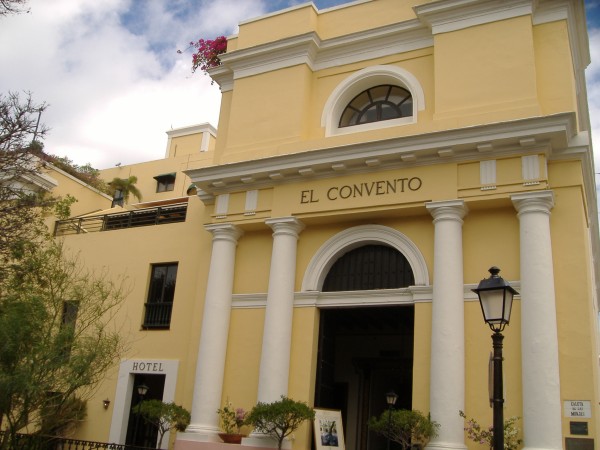
The
magnificent El Convento Hotel
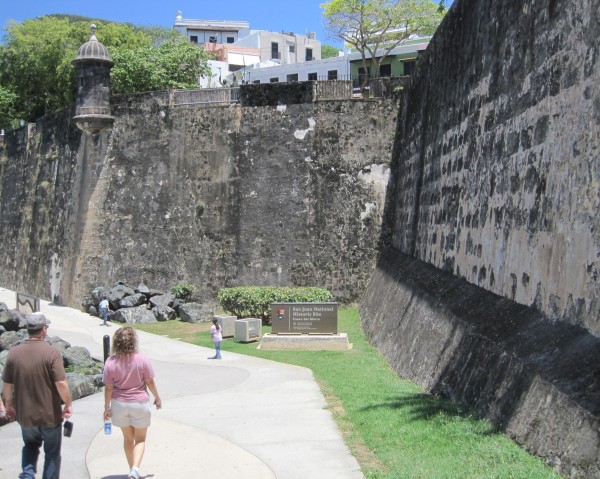
These
massive walls stretch 3 miles. They surround Old San
Juan
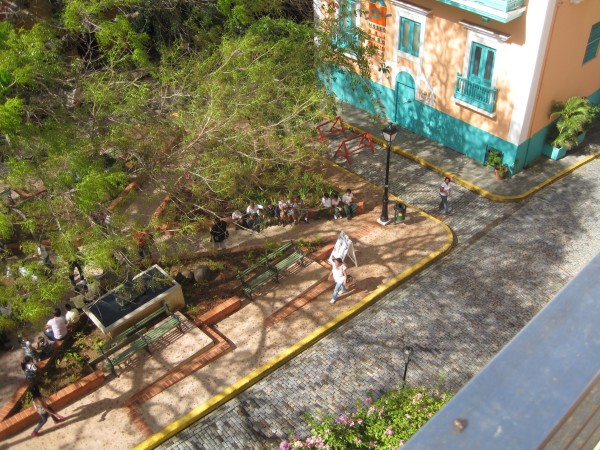
Pastel
buildings, parks, and cobblestone streets add to the charm
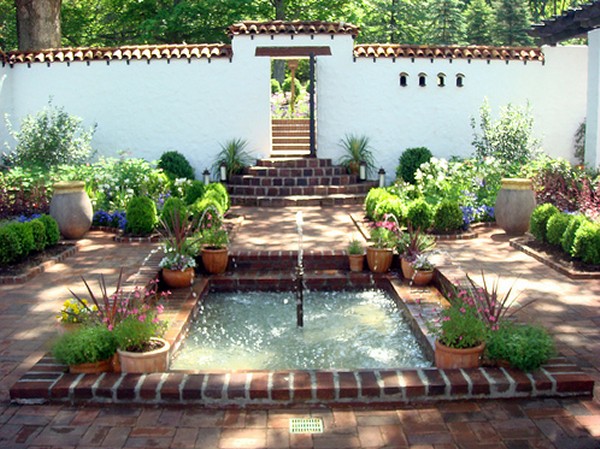
Not all of
San Juan's beauty belongs to the past

What lies
behind those walls? Beautiful courtyards!
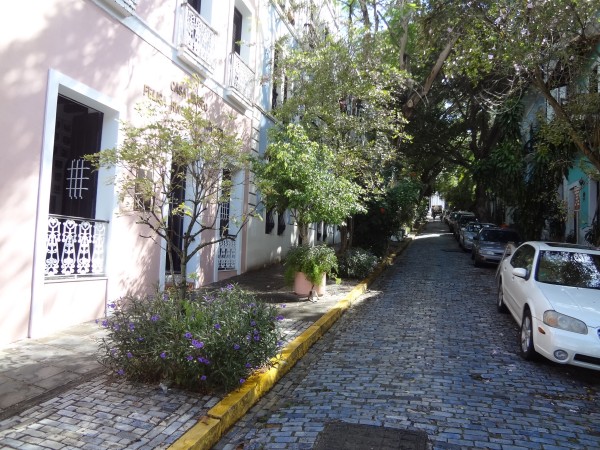 |
| |
|
|
Hurricane Mara Hits San Juan
For our 2011
cruise trip, Mara did an extensive amount of planning.
More so than any other person on the trip other than Marla,
Mara had studied San Juan and the various islands we would
visit extensively.
The first thing
Mara did was take us all out to dinner. It was time to
experience the local cuisine.
Marla loves
spicy food. She loves Asian food. The hotter,
the better.
However, here at
Puerto Rico, Marla met her match. Marla asked what the
local dish was. The waiter told her that mofongo is is
the most popular dish on the island. He explained that
mofongo is a fried plantain-based dish that originated in
Puerto Rico. Marla shrugged. Why not? She
took the waiter's suggestion and ordered the mofongo.
I could barely
control my smile when the mofongo was delivered. My
goodness, there was a veritable mountain of the stuff!
I wish I had taken a picture. It was stacked so high
it looked like you could climb to the top and ski down the
stuff. I have never seen so much food in my life.
Personally, I
wouldn't have touched the stuff with anything other than a
ski pole, but to her credit Marla didn't back down.
Marla fought the
mofongo and the mofongo won.
Marla was never
the same for the rest of the trip. I will spare you
the details.
After dinner,
Mara lined up a lady to give us a tour of Old San Juan.
I will let the pictures tell the next part of the story.
|
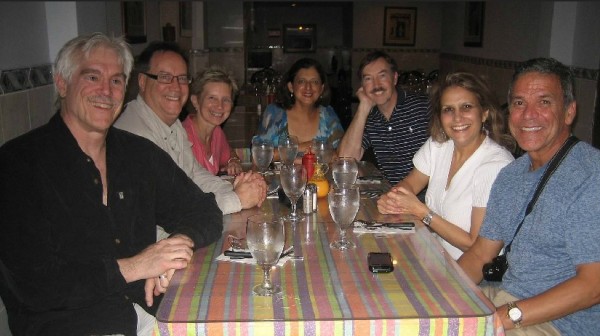
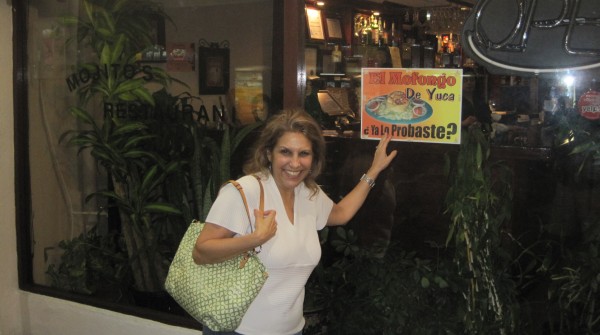 |
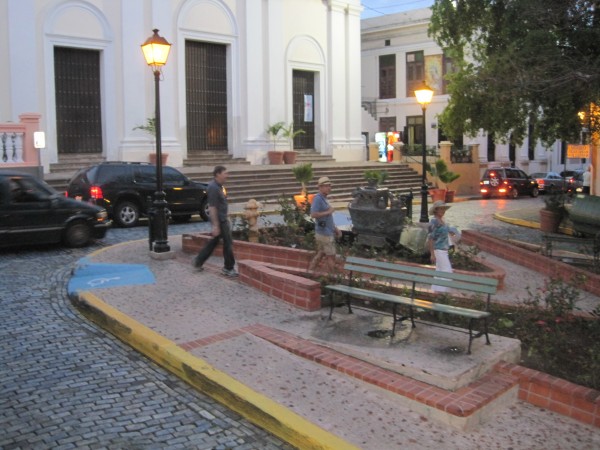
Mara leads
the way
|
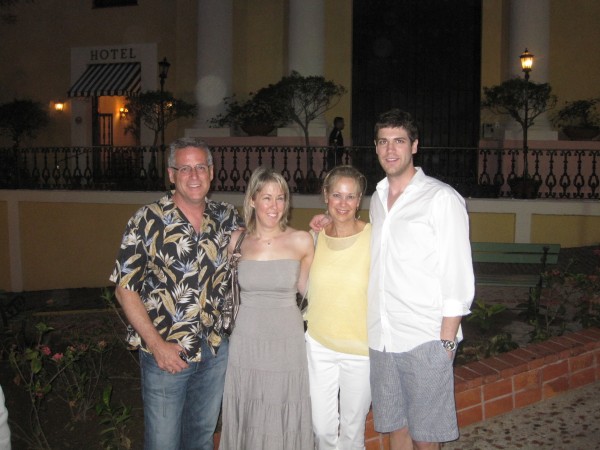
Kurt,
Tiffany, Jean and Ryan
|
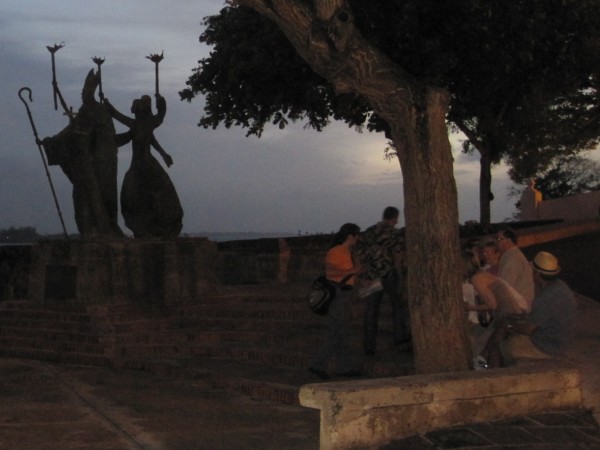
The tour
guide and I did not get along.
|
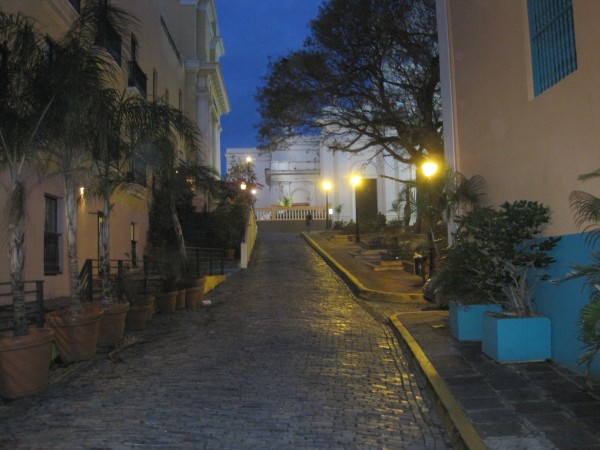
In order
to take pictures, I often lagged behind or wandered around
|
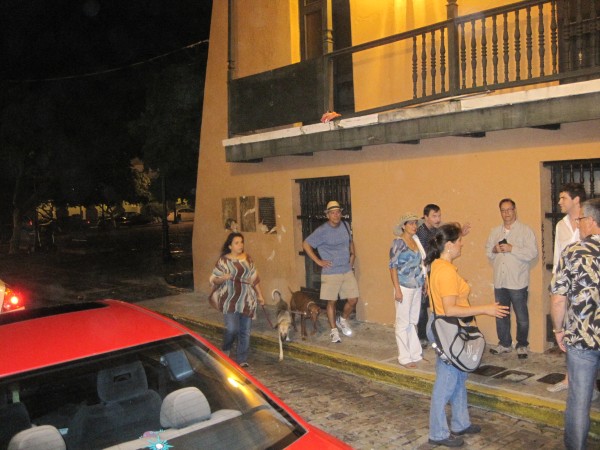
If forced
to guess, I think she thought I was being disrespectful
by taking pictures while she was talking
|
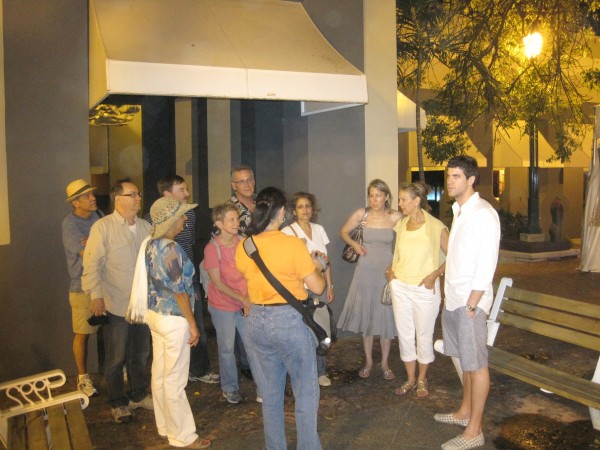
I don't
think she understood that if I don't take pictures,
I can't tell a story after the trip. Oh well |
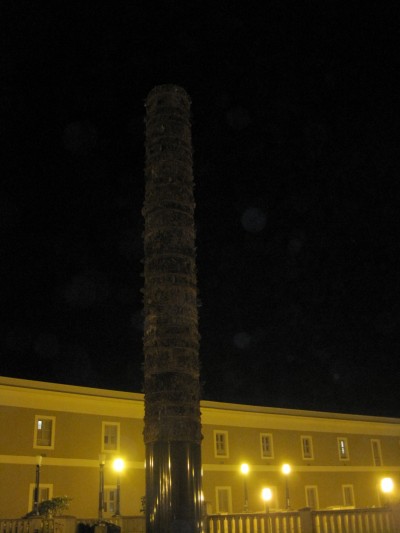 |
My
downfall with the tour guide came when we arrived at this
statue.
In the
dark, I swear it looked just like a giant cigar. It didn't
seem very imaginative. Nor did I have a clue what its
significance was supposed to be.
I think
she heard me call it a cigar as I took the picture. I know
she was mad at me because I saw a huge frown on her face.
I took the
time to come back and look at it again in the daylight. At
least this time I noticed some interesting markings. But I
still had no idea what the point is.
For this
story, I attempted to learn about the statue. The Internet
identifies it as
Totem
Telurico.
It is a contemporary sculpture in the Plaza del Quibto
Centenario, built in 1992 to commemorate the 5th centenary of
Columbus' discovery of America in 1492.
|
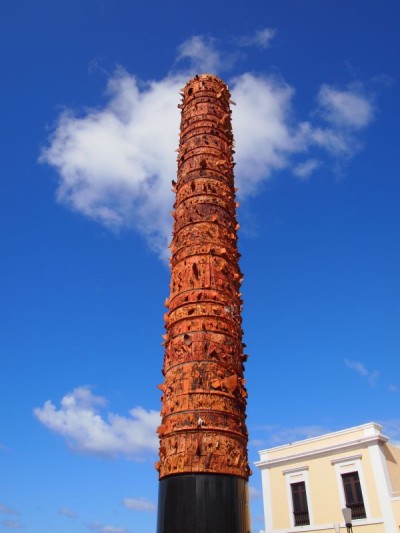 |
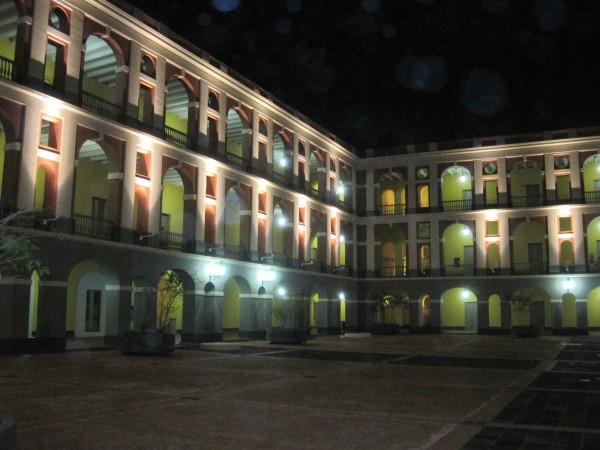
Ballajá
Barracks is a military barracks located in San Juan, Puerto
Rico.
It was built from 1854 to 1864 for the Spanish troops
stationed on the island and their families.
|
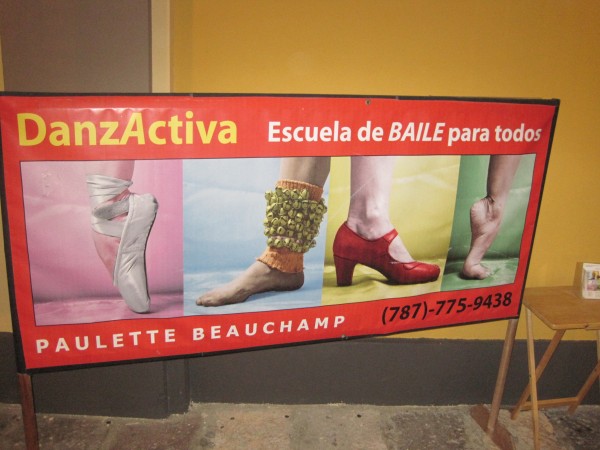
As we
walked past the Ballajá Barracks, I heard music. Curious,
I went to investigate. I discovered DanzActiva, a dance
studio founded by a famous
Puerto Rican ballerina named Paulette Beauchamp.
|
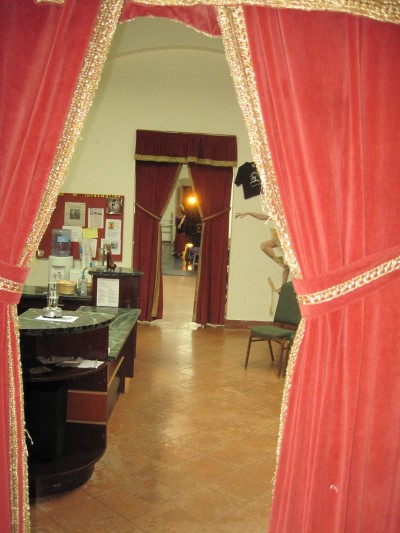 |
Apparently in 1976 the Government of Puerto Rico acquired
the Ballaja building from the Government of the United
States with the commitment of restoring it and using it for
cultural, educative, and touristic purposes.
In
1986, a reform plan for the San Juan Historic Zone was
sketched and the building was restored from 1990 to 1993.
Today, the Ballajá Barracks houses several educational and
cultural organizations, namely the Museo de Las Américas, on
the second floor of the building since 1992. On the first
floor, there are music and dance schools and a library among
other things.
As I
peered through the door, I could see dancing.
So I
quietly moved closer.
|
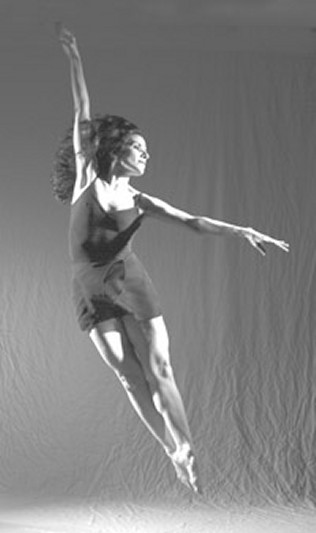 |
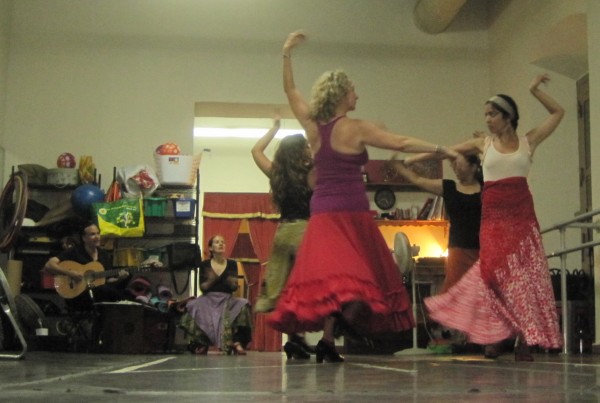
The
mystery was solved. It was a Flamenco dance class.
The women were concentrating so hard I don't think they ever
realized I not only admiring their dancing, but taking a picture
as well.
|
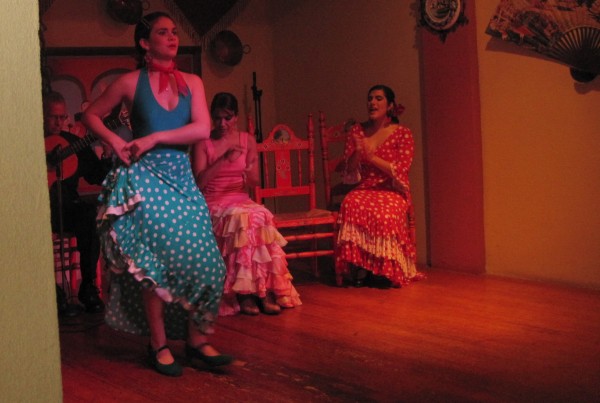
From what
I gather, Flamenco is extremely popular in Puerto Rico. On
the following night, Mara took us to see a Flamenco show.
Who knows?
Maybe these three performers were once students at Danz Activa.
|
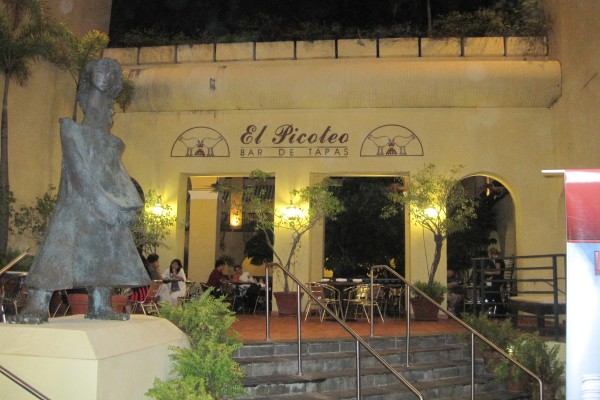
On the way
back, I heard more music. However this sounded much
different. Nosy as always, I peeked in. There was a
beautiful courtyard. |
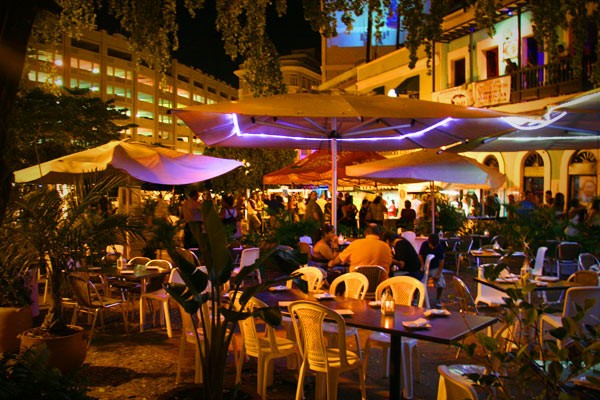
I saw
dancing, but I didn't get close enough to catch a picture.
If I hadn't been so tired, I would have liked to come back and
participate. |
|